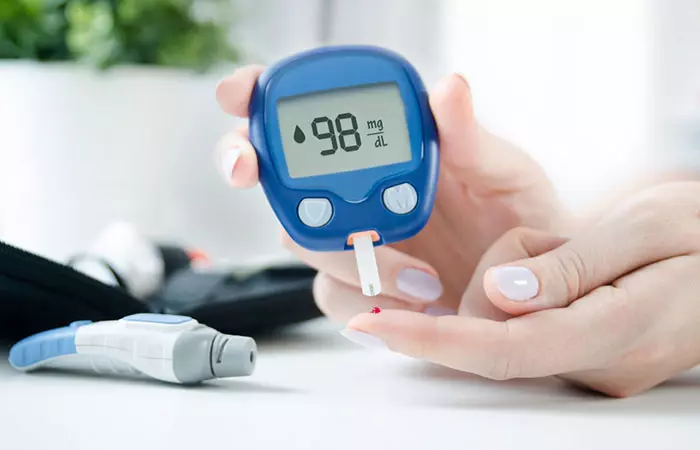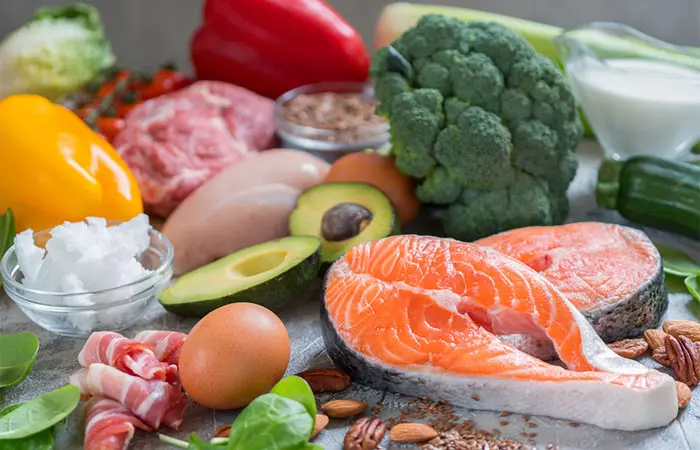What Is A Low-Carb Diet?
A low-carb diet emphasizes the consumption of proteins and fats, primarily obtained from healthy foods. This dietary approach also limits the consumption of carbohydrates, and hence carbohydrate-rich foods, like pasta, bread, and sugary items are highly restricted in this diet. In terms of regular consumption, you can pick protein sources like lean meat, eggs, and fish, while nuts, seeds, and oils can be retained as a source of healthy fats. When compared to low-fat diets, low-carb diets promote effective weight loss for a short term. In addition, these types of diets help in controlling blood sugar levels. They have also been associated with improved markers of heart health, such as reduced triglyceridesi A type of fat found in the bloodstream that at high levels can increase the risk of heart disease. and increased HDL (good) cholesterol levels (1). While carbs are highly limited in this diet, the limitations may differ based on health conditions and weight loss goals. In the section below, you will find out what is the permissible range of carbohydrates for this diet.
How Many Carbs Can Be Taken In A Low-Carb Diet?
Although it is highly subjective, for any low-carb diet, the carbohydrate intake typically ranges from about 20 to 130 grams of net carbohydrates per day (2). This changes as per the individual weight loss goals, their underlying health conditions, and age. It is best to consult a nutritionist or dietitian to decide this range without any risk of the potential side effects. While the principle of this diet is simple to understand, there are various types to explore. The section below lists these in some detail.
Different Types Of Low-Carb Diets
The Ketogenic Diet: A true ketogenic diet is high in fat, allows moderate to low protein consumption, and very low carbohydrates, at around 20-50 grams a day. Since the body is deprived of carbs, the glucose need is fulfilled by ketone production, through a fat-burning mode called ketosisi A metabolic state in which the body primarily burns stored fat for energy due to reduced carbohydrate intake. , which can lead to fast weight loss. Basically, the liver produces ketone bodiesi Molecules produced during fat breakdown which serve as an energy source to replace glucose energy during low-carb diets. from the fat reserves in the absence of glucose from carbs (3). The Atkins Diet: The Atkins diet has four phases that start with strict carb limits which are tweaked to gradually add them back to the diet. It is more like easing into a low-carb lifestyle. The Eco-Atkins Diet: This diet is akin to a plant-based Atkins and is perfect for those who prefer low-carb, vegan, or vegetarian eating. In this diet, you get your protein from foods like tofu, tempeh, and legumes. The Paleo Diet: This diet puts major emphasis on eating natural, unprocessed foods, like fresh meat, fish, fruits, vegetables, nuts, and seeds. There is an unwavering restriction on grains, dairy, and processed items. The Mediterranean Diet: This diet is not super low in carbs, but it is a balanced diet that is good for the heart (4). It particularly encourages the consumption of healthy carbohydrate sources like whole grains, legumes, and vegetables, and sources of healthy fats like olive oil, nuts, and fish.
There is also the high-protein low-carb diet which borrows principles from the Mediterranean and DASH diets, and focuses on reducing carbs while boosting protein intake. In all these diets, carbohydrate limitations remain the same while maintaining a wide variety of food choices. A low-carb diet can help optimize your health in different ways. Let’s take a look.
Benefits Of A Low-Carb Diet
1. Helps Maintain Steady Energy Levels
Anecdotal evidence suggests that when you eat fewer carbs, your blood sugar levels remain stable, preventing energy crashes, and helping you feel more alert during the day. In addition to this, ketones become a highly efficient fuel source for the body and brain. Unlike carbs, which can lead to energy spikes and crashes, ketones provide a steady and consistent source of energy (5).
2. May Improve Blood Sugar Levels
Carbohydrate-balanced diets are like superheroes for those with diabetes because they help keep your blood sugar levels in check, reducing the need for medication. This diet also helps reduce triglycerides and positively affects glycosylated hemoglobin (6). In addition, low-carb diets can induce a state of ketosis, where the body primarily burns fat for energy. This is especially beneficial for those who are overweight. Moreover, ketones are a more stable energy source than glucose, helping to avoid blood sugar spikes and crashes (7). If managing blood sugar levels is a priority for you, then you can pair the low glycemic diet with a low-carb diet, focusing on foods with low GI value to stabilize your blood sugar.
3. May Promote Cardiovascular Health
Low-carb diets lower triglyceride levels and boost HDL (good cholesterol), reducing the risk of heart disease. Moreover, they can effectively reduce serum cholesterol (8). In addition to this, a low-carb diet encourages the consumption of saturated fats like nuts, seeds, and avocados, which reduce the risk of coronary heart disease and also promote cardiovascular health (9).
4. May Improve Appetite Control
Eating a low-carb diet might help you feel less hungry and keep you fuller for long, making it easier to restrict your calorie intake for successful weight management. It was also found that people on low-carb diets experienced reduced appetite and increased feelings of satiety. Feeling satiated may help reduce cravings, promoting mindful eating, which may help with weight management over time. This function may be linked to the process of ketosis, which can help suppress appetite (10). However, further research is warranted in this regard.
5. May Help Reduce Blood Pressure
Research has shown that low-carb diets can be good for controlling blood pressure, as it has a positive impact on systolic blood pressure (11). A low-carb diet may improve both hyperinsulinemia and insulin resistance, thereby promoting the loss of sodium in the urine to reduce blood pressure levels (12). Following a low-carb diet isn’t complicated. While food preferences may vary based on a specific diet plan, here is a guide to what foods you may eat and avoid when on a low-carb diet.
Foods To Eat On A Low-Carb Diet
Proteins
Chicken Turkey Beef Pork Fish Salmon Trout Shrimp Mackerel Eggs
Vegetables
Spinach Kale Broccoli Cauliflower Zucchini Bell peppers
Healthy Fats
Avocado Olive oil Coconut oil Almonds Walnuts Chia and flax seeds Dairy Greek yogurt Cheese
Berries (In Moderation)
Strawberries Blueberries Raspberries
Beverages
Water Green tea Tea, coffee (without added sugar) Sparkling water
Foods To Avoid On A Low-Carb Diet
Sugar
Candies Sugary beverages Cakes Cookies
Starchy Vegetables
Potatoes Corn Peas Butternut squash
Grains
Wheat Rice Oats Barley
Processed Foods
Chips Sugary cereals Fast food burgers Frozen pizzas
Before you start a low-carb diet, it’s important to consult a nutritionist and a doctor to determine what should be your ideal carb intake ratio. Depending on your health goals and preferences, they can help you set a meal plan. The next section has a sample 3-day low-carb meal plan to help you get started.
Sample Low-Carb Diet Plan For Beginners
Day 1 Breakfast
2 scrambled eggs with 1 cup of spinach and ½ cup of mushrooms 1 small avocado
Lunch
6 oz of sliced grilled chicken breast with 2 cups of mixed greens, ½ cup of cherry tomatoes, and 1 tablespoon of olive oil dressing. 1 serving of mixed nuts (almonds, walnuts, and pecans)
Snack
1 cup of Greek yogurt with ½ cup of blueberries
Dinner
6 oz of baked salmon with 1 cup of steamed/grilled asparagus 1 cup of cauliflower rice
Day 2 Breakfast
2-egg omelet with ½ cup of bell peppers and ¼ cup of feta cheese 1 serving of strawberries
Lunch
4 oz of turkey and ½ avocado, wrapped in lettuce leaves 1 serving of cherry tomatoes
Snack
4 celery sticks with 2 tablespoons of peanut butter
Dinner
6 oz of grilled shrimp with 1 cup of zucchini noodles 1 serving of steamed broccoli
Day 3 Breakfast
A glass of spinach, almond milk, and protein powder smoothie 1 small apple
Lunch
5 oz of canned tuna tossed with 2 cups of mixed greens and 2 tablespoons of vinaigrette dressing 1 serving of mixed nuts
Snack
1 cup of cottage cheese with ½ cup of pineapple chunks
Dinner
6 oz of baked chicken thighs with 1 cup of Brussels sprouts 1 serving of cauliflower mash
Note: This is a sample diet plan. You can modify the ingredients, quantities, and portion sizes as per your taste, weight loss goals, and any other dietary requirements. If you are a beginner, it is advised to seek the opinion of a nutritionist or dietitian for a balanced plan. No matter the starting point, it is always recommended to consult a healthcare professional before starting any new diet to avoid any negative effects. Following this diet along with a proper meal plan can offer several health benefits along with visible weight loss. The section below explains how to plan a low-carb diet for weight loss.
How To Do A Low-Carb Diet For Weight Loss
Understand Low-Carb: A low-carb diet involves reducing your daily carbohydrate intake to around 20-100 grams, or even less. This shift aims to push your body into ketosis, a state where it predominantly burns fat for energy.
Choose Your Carbs Wisely: Prioritize complex carbs from sources like leafy greens, non-starchy veggies, and berries. Cut back on simple carbs like sugar, bread, pasta, and processed foods.
Focus On Your Protein Intake: Make lean protein a key part of your diet with options like poultry, fish, lean meats, tofu, and eggs. Protein helps preserve muscle mass as you shed pounds.
Go For Healthy Fats: Don’t shy away from fats; opt for healthy ones such as avocados, nuts, seeds, and olive oil. These fats will help keep you feeling full and satisfied.
Be Mindful Of The Portions: Even in a low-carb approach, portion control is vital to avoid overeating.
Ensure Proper Hydration: Drinking enough water throughout the day supports your metabolism and overall health.
Keep Your Meals Balanced: Plan well-rounded meals by balancing protein, healthy fats, and low-carb vegetables. This ensures you get essential nutrients during your weight loss process.
Track Your Progress: Keep tabs on your carb intake and weight loss progress through a food diary or tracking app.
Seek Professional Advice: Always consult with a healthcare expert or dietitian before embarking on any diet, especially if you have health concerns and sensitivities.
Maintain An Exercise Routine: Incorporate regular physical activity into your daily life to complement your low-carb diet for effective weight loss and overall well-being.
Notwithstanding the advantages, like any other diet, this too comes with a few side effects. The section below explains these in detail. Check it out to know more.
Side Effects Of A Low-Carb Diet
Is a low-carb diet sustainable in the long term? No, a low-carb diet is not sustainable for the long term, as it may trigger nutritional deficiencies. However, if you want to continue it for a while, it is highly recommended to consult your healthcare professional and consider nutritional supplements, if necessary. Is a low-carb diet suitable for everyone? No, a low-carb diet is not suitable for everyone. Individuals with nutritional deficiencies, kidney problems, and eating disorders should not try a low-carb diet as it may aggravate their conditions. Furthermore, this diet is also not suitable for pregnant and breastfeeding women. Can I still get enough fiber on a low-carb diet? Yes, you can maintain adequate fiber intake on a low-carb diet. Include fiber-rich foods like non-starchy vegetables, nuts, seeds, and berries to meet your fiber needs How much weight can I lose on a low-carb diet in two weeks? Weight loss on a low-carb diet can vary significantly among individuals. While some may experience substantial weight loss in two weeks, others may see more modest results. The focus should be on sustainable and healthy weight loss rather than rapid, short-term changes.
Illustration: Low-Carb Diet: Types Benefits And Meal Plan
Many people are often confused about which diet to choose for their weight loss regime – low fat or low carb. Click on the video below to hear it from an expert and make an informed choice.












